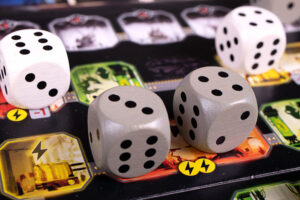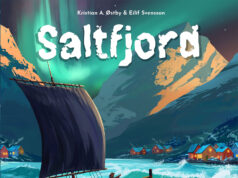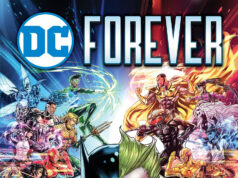 The theme from Under Falling Skies is nothing new. An alien invasion of Earth has been featured in books, movies, and board games for about as long as I can remember. I’m completely unashamed that one of my favorite movies from the 90s was the Will Smith classic Independence Day.
The theme from Under Falling Skies is nothing new. An alien invasion of Earth has been featured in books, movies, and board games for about as long as I can remember. I’m completely unashamed that one of my favorite movies from the 90s was the Will Smith classic Independence Day.
But what’s unique about Under Falling Skies is that it’s a solo game that pits you against the game, mano a mano, to see if you can save Earth. So, fire up those fighter jets as we check out this dice rolling game.
Gameplay Overview:
Under Falling Skies can be played as either a one-off experience or as a multi-game campaign. Regardless of which way you choose, the core of the game remains the same. The game board, which is divided into several rows and five columns, features a mothership at the top that will release fighters that slowly descend towards your base at the bottom.

Each round starts with the player rolling the five dice. Dice can be placed into a room in your base, to later activate that room’s special power. Most rooms will be as effective as the die you place there (so a 5-die placed in an energy room will generate 5 energy for you). However, the trick is that as soon as you place the die (before you even get to activate the room) any ships in that column descend a number of spaces equal to the die you placed. So, that same 5 that earns you boku energy is causing the ship to descend five spaces towards your base. If a ship makes it to your base, you take damage as the ship kamikazes its way into your bunker.
Something else to keep in mind is that the dice come in either white or grey colors. After you place a white die, the rest of the dice in your pool are all rerolled. This is the only way you can reroll dice.
Once you’ve placed all five of your dice, you now activate the rooms you chose. Rooms will have different effects, such as gaining you energy, research points, automated robots, anti-aircraft guns, or fighters to shoot down enemy ships. You can also place dice to move your excavator, which will tunnel its way through your base unlocking new and more powerful rooms. Some rooms cost energy to use, while others will modify the dice you placed with either stronger or weaker results.
After you finish activating all your rooms, the Mothership descends one level down, causing bad things to happen depending on what icons are in its new row. Any destroyed ships (or ones that hit your base) are respawned now back on the mothership and a new round begins.
The game ends with a win if you advance up to the top of the research track, but you lose if your base is destroyed or the mothership makes it to the lowest level.

Game Experience:
Due to the hot mess that is 2020, I’ve been doing a lot more solo gaming than I used to. Getting groups together is just much more difficult, for obvious reasons. So, I eagerly tore into Under Falling Skies as I loved both the theme and have always been a fan of dice games.
And I must say, game designer Tomáš Uhlíř really created a fairly unique game with Under Falling Skies. He created a system that really is a double edges sword with the dice. For example, you really want those high numbers, because it gives you more energy, more research points, stronger guns to kill fighters, etc… yet, on the other hand, every 6 you place means that an enemy fighter is going to be dropping six spaces towards your base. This is almost a quarter of the way through the board, giving you have less time to chew it up with your anti-fighter guns.

All these together lead to a really brainy game that’s not as casual as it first appears. This is compounded by the fact that there are icons all over the board. Some will move fighters to an adjacent column, while others will cause the mothership to drop down a space immediately. So, something you must think about when moving a fighter is that if it lands on an arrow for a column you haven’t activated yet, it could conceivably move twice in a round! There is almost a chess-like feel here where you need to be planning your moves in advance. If you are looking for a very thinky, brain burner, you’ve found it here.
Yet if that was all there was with the game, I don’t think it’d be worth more than a casual play or two. While the gameplay is definitely solid and well thought out, things get repetitive pretty quickly. It wasn’t until I dived into the campaign mode where Under Falling Skies started to show some life. For the sake of spoilers, I’m not going to talk too much about the campaign play. But suffice to say, you’ll have lots of new locations, new rules to gronk, challenging scenarios where the game ups the difficulty level. In fact, once you have finished the campaign, you can take everything you’ve got and mix and match it all together. This helps create a game with a bucket full of replay value.

Yet even with a full campaign to explore, my biggest knock at Under Falling Skies is that it starts to feel repetitive from game to game. What was really interesting in my first play started to wear thin by game five. Even the changeups from the campaign don’t alter the core gameplay sufficiently to make it feel fresh enough for me to want to dive back in over and over. While I won’t say that I’ve seen all this game has to offer, I also am not really feeling drawn into getting it back to the table anytime soon.
The other thing to be aware of is that Under Falling Skies is a ponderous game that’s going to require every ounce of mental muscles you have to win. Every dice placement matters, and if you go into Under Falling Skies expecting a thrilling dice chucker, you will be disappointed. This is more of a chess match than a craps game. There also isn’t a ton of options in the way of dice manipulation. You have two rerolls depending on when you spend your white dice, and that’s about it. So sometimes you will be stuck with dice that aren’t going to be very useful for you, or no way to move a fighter onto a space that will destroy it. This is almost a little surprising giving the thinky nature of the game.
Final Thoughts:
For those looking for a solo experience that is well thought out, and offers a solid amount of replay value, Under Falling Skies has a lot to offer. It has excellent core mechanics, is full of many meaningful decisions, and has a replayable campaign to spice things up. I can also say that the production values are excellent. The translucent fighters are fun to play with, the art is fantastic, and everything else feels well put together.
That being said, it’s probably not going to be a game for everyone, as its gameplay can get repetitive after a while and it lacks excitement. While Under Falling Skies is definitely a solid game, I’m just not drawn to getting it back to the table anytime soon.
Final Score: 3.5 Stars – A solo game that will appeal to someone who wants to stretch those mental muscles.
 Hits:
Hits:
• Really solid core game loop
• Incredibly thinky gameplay
• Campaign mode is both repayable and changes things up.
Misses:
• Can get repetitive at times.
• Not much in the way to dice manipulation.
























Tony, whatever you do when writing game reviews, be absolutely sure not to inform your readers as to how many players a game will accommodate. This is useless information that none of us need to know. We would rather buy the game first and then be surprised as to how many can play once we get it home. So remember, never tell us how many players can play. Let us guess.
Seriously, c’mon man. What’s wrong with telling us “HOW MANY PLAYERS”? Is there some hidden reason why game reviewers (and some developers) hide this from us? If so, please enlighten me.
Ron. Literally the first sentence of the second paragraph says that it’s a solo board game. Solo means one, sorry if that’s not clear to you. ¯\_(ツ)_/¯
Failing that, literally every board game has the player count on the box somewhere. There is also a ton of ways you can find out this information. No one is hiding this from you.
This is hilarious. Board game developers are hiding player counts from us?? Ron doesn’t know how many players this solo game will accommodate? There’s so much going on here.
This is actually a below average rating for such a highly praised game. 3.5 stars? Look at what the author states are hits. How can you say that those hits equate to only 3.5 stars? Those are equivalent to about 4.5. Even those misses don’t justify a 3.5 rating.
Other people may really enjoy the game, but I stand by what I said in my review. I think it’s a good game, but not a great one. Definetly one that I’ve not had much desire to revisit since my last play. But to each their own.
*mano a mano 🙂
Ha, good catch. I clearly didn’t mean monkey vs monkey. 😀
Any extra thoughts on the campaign? I know its hard to talk about without spoiling things, but how much does it impact the game? Is there any real story does winning/losing a scenario impact the rest of the campaign? I’d love to hear more about that aspect
For me, the campaign changed up the games a little via rules. While there is some story, it’s very light and doesn’t really drive the campaign at all.